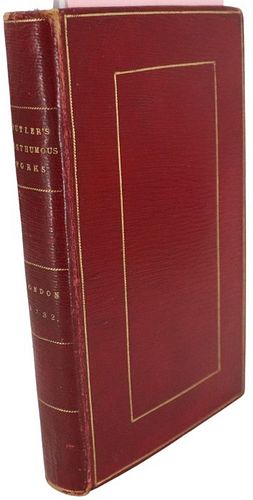This book is entitled "The Posthumous Works Of Mr Samuel Butler" in a fine binding by Larkins, and it was published in 1732.
The full title page reads "The Posthumous Works Of Mr Samuel Butler (Author of Hudibras) Compleat in One Volume: Written in the Time of the Grand Rebellion, and in the Reign of King Charles II. Being A Collection of Satires, Speeches, and Reflections upon those Times. Publish'd from Original M.SS. and Scarce and Valuable Pieces formerly Printed. To which is added, A Key to Hudibras by Sir Roger L'Estrange. The Fourth Edition, Corrected. Adorn'd with Cuts. London: Printed for and Sold by Richard Baldwin, at the Blue Bible in St. Paul's Churchyard. 1732."
The book has five horizontal gilt-ruled bands and gilt lettering on the spine, a beautiful red cover with gilt-ruled borders, a gilt-ruled border with marbled endpapers, "Larkins" is in gilt at the bottom of the front paste-down, there's a frontis portrait of Samuel Butler, then the title page, a three-page dedication to Prince James, the Duke of Ormond, two pages addressed to the Reader, three Contents pages, and 326 pages of text and 11 plates, including the frontispiece, an Alphabetical Key to Hudibras that starts on 326 and runs to page 336 (the end), and all the edges are gilt.
Samuel Butler (1613 - 1680) was an English poet and satirist, chiefly remembered now for a long satirical poem titled Hudibras. He was born in Worcestershire and brought up in the household of Sir William Russell and became his clerk, and he was educated at King's School in Worcester and tried his hand at painting, but never amounted to much that way, and he studied law, but never practiced. He began the first part of Hudibras in 1662, and an early purchaser of the book was Samuel Pepys, no less. He apparently worked for the Duke of Buckingham in 1670 and accompanied him on a diplomatic mission to France. Butler also received financial support in the form of a grant from King Charles II, and he died from consumption in 1680.
Hudibras is directed against religious sectarianism and the poem was very popular in its day. He also wrote short biographies, epigrams and verse, the earliest surviving from 1644. Of his verses, the best known is "The Elephant on the Moon", about a mouse trapped in a telescope; it was a satire on Sir Paul Neale of the Royal Society. Neale was an English astronomer and politician who sat in the House of Commons and studied astronomy and built telescopes. Butler felt Neale was a conceited virtuoso, so he wrote this little ditty about a mouse on the moon: the poem tells of someone who made a great discovery of an elephant on the moon, which on closer examination turned out to be a mouse that had lost its way and somehow got into the telescope.
The book measures 6 1/2 x 3 7/8 in. wide and is in very good condition. The binding is tight and the pages and text are very clean, as are the plates, with a couple of spots here and there in the book and that's it. Some of the pages towards the end have the tops slanted and seemingly cut off, apparently in the binding process, but that is just a trick of the eye and no real cutting actually happened - the pages are very much intact. There's light rubbing at the heel and crown and along the edges of the spine, and light rubbing at the tips, and the book is still very attractive and a scarce work that offers insights into an interesting English character of the seventeenth century.
#48 #5007
Available payment options
We accept all major credit cards, wire transfers, money orders, checks and PayPal. Please give us a call at (941) 359-8700 or email us at SarasotaEstateAuction@gmail.com should you have any questions about payment.






















